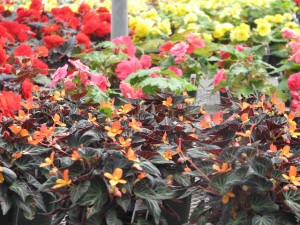It’s time to think about gardens full of flowers – and to visit greenhouses full of color to add to your own landscape! If you’ve heard about garden center plants containing pesticides – in particular neonicitinoids – that are toxic to honeybees and other native pollinators, you might wonder if you should still buy those plants.
It is a complex issue and we don’t have all the answers. But there are some things that you can do to promote pollinators in your own garden:
Talk to the growers where you buy your plants and find out what they are doing to reduce potential pesticide effects on pollinators.
Growers only use pesticides when they have to. Some growers have stopped using neonicitinoids, others are applying them early so that no residues are left. Some plants are never treated with neonics. You won’t know until you ask!
Plant a wide diversity of flowers that bees use as food and shelter.
Another factor that leads to bee deaths is lack of habitat as wild lands become urbanized. You can create your own pollinator haven and have the pleasure of both the flowers and the bees and butterflies. You could even (gasp!) let a few weeds go to flower. It’s all habitat when you’re a honeybee!
Use IPM in your own backyard.
Grow your garden with pollinators in mind. Identify things you think are pests. Maybe you can just live and let live! Keep your plants happy and healthy with proper watering, fertilizer, and spacing! Don’t spray any pesticides unless you REALLY have to (and then think again!). And that’s not just on the flowers and veggies but the lawn, too. And if you have to, read the pesticide labels to find out their effects on bees and other pollinators.
Learn more about the issue.
Check out IPM’s pollinator page – and keep coming back. There is new information coming out all the time.
Dr. Dave Smitley at Michigan State University is doing a lot of research on ornamentals and pollinator issues and has written articles for home owners, too.
Be a honey to your bees!
